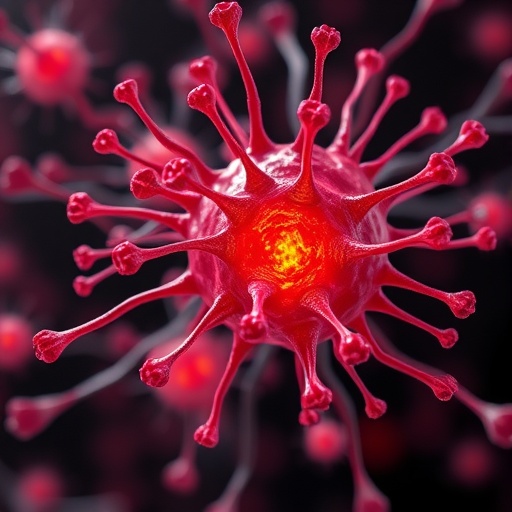In the realm of cellular biology, the ability of a single cell to sense and respond to its environment has long fascinated scientists. Yet, recent research has revealed that this sensory power extends far beyond the capabilities of isolated cells. Engineers at Washington University in St. Louis have uncovered groundbreaking insights into how epithelial cells collaborate to enhance their environmental sensing, potentially revolutionizing our understanding of cancer cell migration and tissue dynamics.
This pioneering study, published in the prestigious journal Proceedings of the National Academy of Sciences (PNAS), challenges the traditional view that cells only interact with their immediate surroundings. Instead, cells appear capable of perceiving mechanical cues from layers of extracellular matrix (ECM) located much deeper than previously assumed. This phenomenon, termed “depth mechano-sensing,” enables cells—notably cancerous ones—to detect and navigate complex tissue landscapes up to 100 microns away.
Mechanical engineer and materials scientist Amit Pathak, who led the research effort, explains that a cell’s mechano-sensing ability depends on its interaction with the fibrous collagen structure that dominates the ECM. By exerting force on this collagen network, cells can physically deform their surroundings, “feeling” the rigidity and composition several layers in depth. This capacity is crucial, as the ECM’s stiffness varies significantly, ranging from soft tissues to rigid bone, providing essential guidance cues for cellular migration.
Previous investigations by Pathak and collaborators demonstrated that single abnormal cells—characterized by a phenomenon called “high front-rear polarity,” common in motile cancer cells—could extend their mechano-sensing reach up to approximately 10 microns. However, the current research reveals a striking amplification of this sensing range when epithelial cells function cohesively as collectives rather than individually. This cellular cooperation dramatically increases the force generated against the collagen fibers, allowing the group to sense up to ten times deeper into the matrix.
What makes this collective behavior particularly intriguing is its implication in cancer progression. Tumor cells often exploit enhanced mechano-sensation to breach primary tumor boundaries, migrating into surrounding tissues and evading immune detection. With the capability to sense and respond to ECM properties far beyond the immediate microenvironment, cancerous epithelial collectives may thus orchestrate more efficient and covert invasion strategies.
Pathak’s team’s computational models shed light on the mechanics underlying this collective sensing. They outline two principal phases: one involving initial cell clustering and another directed migration. The forces generated during cell aggregation enable the group to “probe” the mechanical landscape more effectively than any solitary cell could, setting directional cues that influence not only where but also how cells disperse throughout layered tissue matrices.
The biophysical foundation of this enhanced sensing involves complex interactions between cell-generated traction forces and the nonlinear, fibrous nature of collagen matrices. By remodeling collagen fibers under tension, cells can transmit mechanical signals across distances much larger than their own size. This emergent property of tissue collectives represents a paradigm shift in how scientists view cellular communication and environmental sensing.
Understanding the molecular regulators that enable or restrict this extended sensing ability stands as the next major milestone. Identifying these factors could lead to innovative therapeutic targets. If researchers can inhibit the cell’s ability to perceive the ECM beyond a certain depth, it may be possible to impair the metastatic potential of cancer cells, effectively containing tumors and limiting their invasive spread.
The broader implications of this work transcend oncology. Epithelial cells line almost all body surfaces and are integral to development, wound healing, and immune responses. Their mechano-sensing capacity likely influences a spectrum of physiological and pathological processes, suggesting new avenues for research in tissue engineering and regenerative medicine.
Furthermore, this research contributes to the evolving discourse on how physical forces shape biological outcomes. It emphasizes that cells do not merely respond to chemical signals but also interpret mechanical information transmitted through their surroundings, with collective behavior amplifying these effects in ways previously unimagined.
Pathak and his PhD student Hongsheng Yu, co-authors of this study, have thus paved the way for a deeper understanding of cellular interactions at tissue interfaces. Their findings hint at a form of “cellular clairvoyance,” where groups of cells anticipate environmental obstacles and opportunities through mechanical perception, guiding their movements and fate decisions.
The funding support of the National Institutes of Health and the National Science Foundation underscores the importance and potential impact of this research. As science advances, the intricate dance between cells and their physical environment continues to unravel surprising layers of complexity, challenging existing paradigms and opening new frontiers.
In conclusion, the discovery of emergent depth-mechano-sensing in epithelial collectives marks a transformative step in cell biology. By revealing how cells extend their sensory reach collectively, this work not only deepens our grasp of cancer metastasis but also enriches the broader understanding of tissue mechanics and cellular communication. Future explorations into targeting this capability hold promise for potentially halting cancer’s deadly migration and inspiring novel biomedical innovations.
Subject of Research: Cellular mechanosensing and collective epithelial cell behavior in cancer migration
Article Title: Emergent Depth-Mechano-Sensing of Epithelial Collectives Regulates Cell Clustering and Dispersal on Layered Matrices
News Publication Date: September 11, 2025
Web References:
- Research article: https://www.pnas.org/doi/10.1073/pnas.2423875122
- Researcher profile: https://engineering.washu.edu/faculty/Amit-Pathak.html
- Previous related research: https://doi.org/10.1016/j.celrep.2023.112362
- Source news: https://engineering.washu.edu/news/2025/Working-together-cells-extend-their-senses.html
References:
Hongsheng Y, Pathak A. Emergent depth-mechanosensing of epithelial collectives regulates cell clustering and dispersal on layered matrices. PNAS, Sept. 11, 2025.
Image Credits: Provided by McKelvey School of Engineering, Washington University in St. Louis
Keywords: Cell proliferation, Extracellular spaces, Cellular physiology




